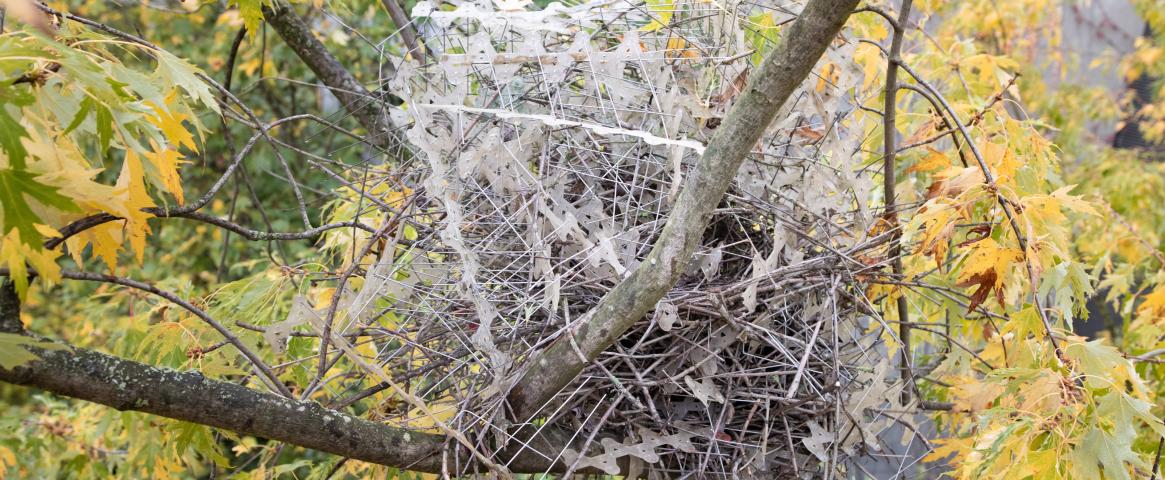This student story was published as part of the 2023 NASW Perlman Virtual Mentoring Program organized by the NASW Education Committee, providing science journalism practice and experience for undergraduate and graduate students.
Story by Paige Nicklas
Mentored and edited by Jennifer Carr
Birds using man-made materials to build their nests is not a new phenomenon. However, a study published this summer has found that some city birds are building their nests from metal anti-bird spikes—the very devices people put on buildings to deter birds from nesting or perching.
While humorous, these city birds are displaying a fascinating adaptation that is a direct result of human action. The birds now join other animals who have recently made the news for their rebellious behavior involving human devices (for example, increasing numbers of orcas sinking boats and otters who steal surf boards).
Humans and other animals today are living in the unofficial geological time period known as the Anthropocene. This period is characterized by humans being the single most influential species on the planet, and the ripple effect human activities and infrastructure have on the rest of the planet. As humans incessantly impact wildlife and their habitats, researchers say more surprising behaviors across species may emerge. What will the impact be on humans and other animals? This is just the type of question that study author Auke-Florian Hiemstra, M.Sc., a Ph.D. candidate at Naturalis Biodiversity Center, hopes to better understand someday. His research focused on birds using artificial items to build nests.
For birds in urban areas, there is less biomass like trees and bushes with which to build their nests, so they must adapt out of necessity and use anthropogenic (or human-made) materials. However, the nests built by the crows and magpies that were studied by Hiemstra and his colleagues show characteristics of use beyond simple necessity; the birds re-used the spikes to their own advantage.
“[T]he magpies appear to be using the pins exactly the same way we do: to keep other birds away from their nest,” Hiemstra said in a news release.
The discovery of four nests built from anti-bird spikes is described in the journal Deinsea. In one of the nests built by a magpie in Belgium, 604 spikes were used in the nest construction. In another, an estimated 1,500 spikes were used. Some of these spikes even had traces of the adhesive used to attach them to buildings, suggesting that the birds had ripped them off to use for their own purposes. In the nest, the spikes pointed outward and created a protective dome around the nest.
Frank La Sorte, Ph.D., a senior research associate at the Cornell Lab of Ornithology in the United States who was not involved in this study, noted that this usage mimics a magpie’s natural nest building behaviors. “Magpies naturally use spikey things [for example, thorny twigs] in their nests,” he said. “I imagine the [anti-bird] spikes are a visual cue for something … that magpies naturally search for to build their nests. Based on [magpie’s] natural search pattern, they have adapted to overlay this onto an artificial environment.”
If building nests with anti-bird spikes results in greater survival of more young magpies, “the young may replicate that behavior,” La Sorte added.
To determine if the innovative behavior pays off for the birds, scientists will need to keep an eye on how the birds born into the spike-defended nests fare over time compared with the baby birds coming from nests made of natural materials. La Sorte commented that humans are creating unique ecosystems within urban areas, with birds specifically evolved to them. When asked if he thinks that is a good thing, he laughs, “Well, that depends on how long you think humans will be on the Earth.”
La Sorte wondered if all these observations are part of a larger trend and if we will see more behaviors like this as a response to extreme climate changes pushing animals to change.
Heimstra said he is not surprised by the birds, though: “In today’s Anthropocene, there is more anthropogenic material present than natural biomass ... anything may become part of a bird’s nest today.”
Paige Nicklas is a Neuroscience PhD student at the University of Rochester where she studies how our brain changes when we are doing something with our mind and with our body at the same time. She is a contributing editor and writer for Knowing Neurons. Connect with her on LinkedIn or email her at prnicklas11@gmail.com.
Main Image Caption: Magpie nest made of anti-bird spikes
Main Image Credit and Video Courtesy Credit: Auke-Florian Hiesmtra
The NASW Perlman Virtual Mentoring program is named for longtime science writer and past NASW President David Perlman. Dave, who died in 2020 at the age of 101 only three years after his retirement from the San Francisco Chronicle, was a mentor to countless members of the science writing community and always made time for kind and supportive words, especially for early career writers. Contact NASW Education Committee Co-Chairs Czerne Reid and Ashley Yeager and Perlman Program Coordinator Courtney Gorman at mentor@nasw.org. Thank you to the many NASW member volunteers who spearhead our #SciWriStudent programming year after year.
Founded in 1934 with a mission to fight for the free flow of science news, NASW is an organization of ~ 2,600 professional journalists, authors, editors, producers, public information officers, students and people who write and produce material intended to inform the public about science, health, engineering, and technology. To learn more, visit www.nasw.org


